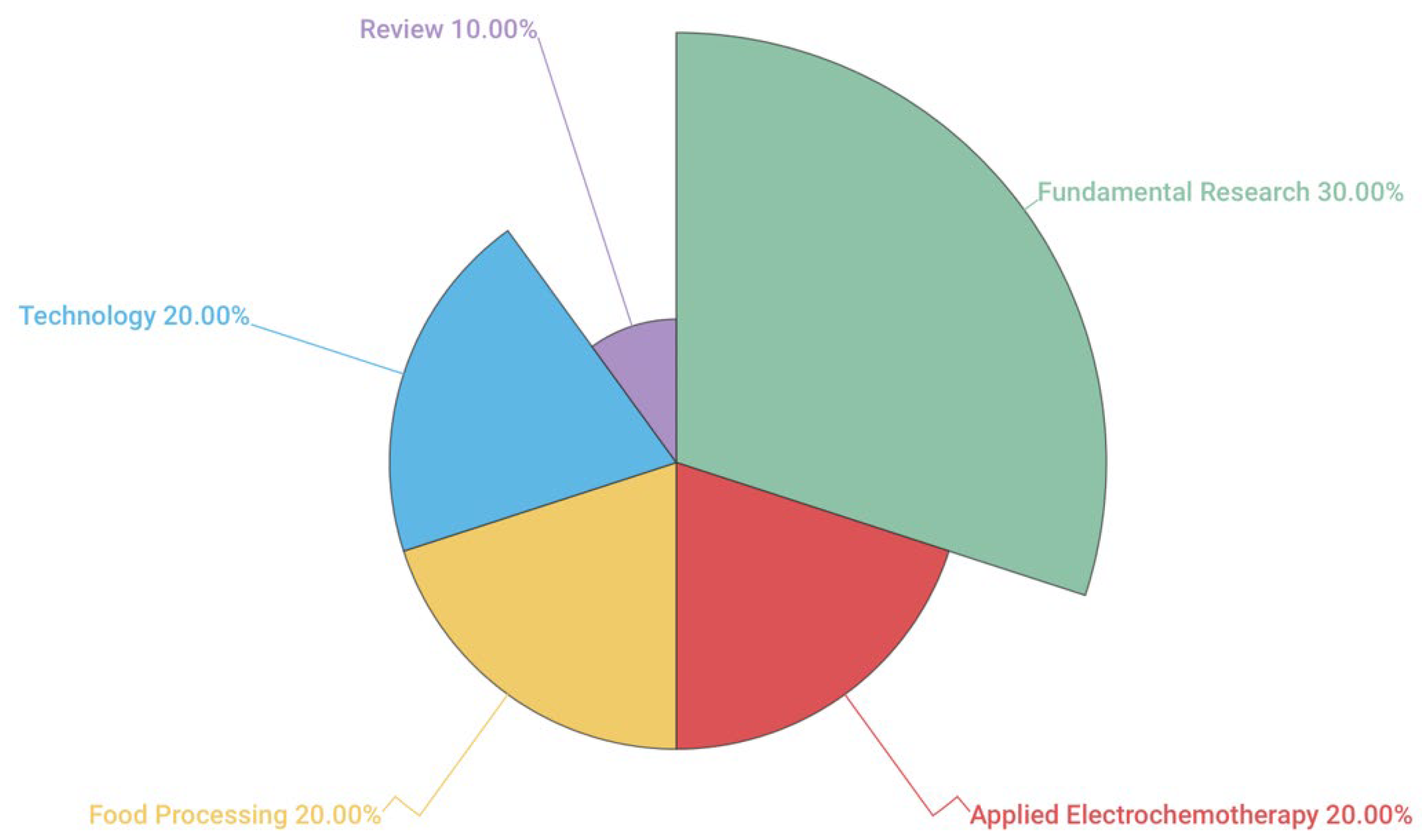Special Issue on Electroporation Systems and Applications
1. Introduction
2. Special Issue on Electroporation Systems and Applications
3. Future of Electroporation-Based Technologies
Institutional Review Board Statement
Informed Consent Statement
Data Availability Statement
Acknowledgments
Conflicts of Interest
References
- Tsong, T.Y.Y. Electroporation of cell membranes. Biophys. J. 1991, 60, 297–306. [Google Scholar] [CrossRef] [PubMed]
- Neumann, E.; Rosenheck, K. Permeability changes induced by electric impulses in vesicular membranes. J. Membr. Biol. 1972, 10, 279–290. [Google Scholar] [CrossRef] [PubMed]
- Sersa, G.; Miklavcic, D.; Cemazar, M.; Rudolf, Z.; Pucihar, G.; Snoj, M. Electrochemotherapy in treatment of tumours. Eur. J. Surg. Oncol. 2008, 34, 232–240. [Google Scholar] [CrossRef] [PubMed]
- Satkauskas, S.; Bureau, M.F.; Puc, M.; Mahfoudi, A.; Scherman, D.; Miklavcic, D.; Mir, L.M. Mechanisms of in vivo DNA electrotransfer: Respective contribution of cell electropermeabilization and DNA electrophoresis. Mol. Ther. 2002, 5, 133–140. [Google Scholar] [CrossRef] [PubMed]
- Garner, A.L. Pulsed electric field inactivation of microorganisms: From fundamental biophysics to synergistic treatments. Appl. Microbiol. Biotechnol. 2019, 103, 7917–7929. [Google Scholar] [CrossRef] [PubMed]
- Esser, A.T.; Smith, K.C.; Gowrishankar, T.R.; Weaver, J.C. Towards solid tumor treatment by nanosecond pulsed electric fields. Technol. Cancer Res. Treat. 2009, 8, 289–306. [Google Scholar] [CrossRef] [PubMed]
- Golberg, A.; Sack, M.; Teissie, J.; Pataro, G.; Pliquett, U.; Saulis, G.; Stefan, T.; Miklavcic, D.; Vorobiev, E.; Frey, W. Energy-efficient biomass processing with pulsed electric fields for bioeconomy and sustainable development. Biotechnol. Biofuels 2016, 9, 94. [Google Scholar] [CrossRef] [PubMed]
- Rakoczy, K.; Kisielewska, M.; Sędzik, M.; Jonderko, L.; Celińska, J.; Sauer, N.; Szlasa, W.; Saczko, J.; Novickij, V.; Kulbacka, J. Electroporation in Clinical Applications—The Potential of Gene Electrotransfer and Electrochemotherapy. Appl. Sci. 2022, 12, 10821. [Google Scholar] [CrossRef]
- Chiaramello, E.; Fiocchi, S.; Bonato, M.; Gallucci, S.; Benini, M.; Parazzini, M. Cell transmembrane potential in contactless permeabilization by time-varying magnetic fields. Comput. Biol. Med. 2021, 135, 104587. [Google Scholar] [CrossRef] [PubMed]
- Šalaševičius, A.; Uždavinytė, D.; Visockis, M.; Ruzgys, P.; Šatkauskas, S. Effect of Pulsed Electric Field (PEF) on Bacterial Viability and Whey Protein in the Processing of Raw Milk. Appl. Sci. 2021, 11, 11281. [Google Scholar] [CrossRef]
- Novickij, V.; Staigvila, G.; Murauskas, A.; Rembialkowska, N.; Kulbacka, J.; Novickij, J. High Frequency Bipolar Electroporator with Double-Crowbar Circuit for Load-Independent Forming of Nanosecond Pulses. Appl. Sci. 2022, 12, 1370. [Google Scholar] [CrossRef]
- Agnass, P.; van Lienden, K.P.; van Gulik, T.M.; Besselink, M.G.; Crezee, J.; Kok, H.P. Improving Prediction of the Potential Distribution Induced by Cylindrical Electrodes within a Homogeneous Rectangular Grid during Irreversible Electroporation. Appl. Sci. 2022, 12, 1471. [Google Scholar] [CrossRef]
- Matys, A.; Dadan, M.; Witrowa-Rajchert, D.; Parniakov, O.; Wiktor, A. Response Surface Methodology as a Tool for Optimization of Pulsed Electric Field Pretreatment and Microwave-Convective Drying of Apple. Appl. Sci. 2022, 12, 3392. [Google Scholar] [CrossRef]
- Potočnik, T.; Sachdev, S.; Polajžer, T.; Lebar, A.M.; Miklavčič, D. Efficient Gene Transfection by Electroporation—In Vitro and In Silico Study of Pulse Parameters. Appl. Sci. 2022, 12, 8237. [Google Scholar] [CrossRef]
- Perminaitė, E.; Zinkevičienė, A.; Malyško-Ptašinskė, V.; Radzevičiūtė, E.; Novickij, J.; Girkontaitė, I.; Novickij, V. Killing Bacteria Using Acetic Acid and Nanosecond Pulsed Electric Fields—An In Vivo Superficial Infection Model Study and Immune Response. Appl. Sci. 2023, 13, 836. [Google Scholar] [CrossRef]
- Palepšienė, R.; Maciulevičius, M.; Ruzgys, P.; Jakštys, B.; Šatkauskas, S. The Influence of Calcium Ions on the Electrotransfer Efficiency of Plasmid DNA and Cell Viability. Appl. Sci. 2023, 13, 1983. [Google Scholar] [CrossRef]
- Tunikowska, J.; Rembiałkowska, N.; Michel, O.; Mączyńska, J.; Antończyk, A.; Prządka, P.; Kiełbowicz, Z.; Kulbacka, J. Electrochemotherapy with Bleomycin Supported by NIRF Imaging with Indocyanine Green (ICG)—In Vitro and In Vivo Case Study. Appl. Sci. 2023, 13, 2027. [Google Scholar] [CrossRef]
- Di Monaco, A.; Vitulano, N.; Troisi, F.; Quadrini, F.; Romanazzi, I.; Calvi, V.; Grimaldi, M. Pulsed Field Ablation to Treat Atrial Fibrillation: A Review of the Literature. J. Cardiovasc. Dev. Dis. 2022, 9, 94. [Google Scholar] [CrossRef] [PubMed]
- Sano, M.B.; Fan, R.E.; Cheng, K.; Saenz, Y.; Sonn, G.A.; Hwang, G.L.; Xing, L. Reduction of Muscle Contractions during Irreversible Electroporation Therapy Using High-Frequency Bursts of Alternating Polarity Pulses: A Laboratory Investigation in an Ex Vivo Swine Model. J. Vasc. Interv. Radiol. 2018, 29, 893–898. [Google Scholar] [CrossRef] [PubMed]
- Miklavcic, D.; Novickij, V.; Kranjc, M.; Polajzer, T.; Meglic, S.H.; Napotnik, T.B.; Romih, R.; Lisjak, D. Contactless electroporation induced by high intensity pulsed electromagnetic fields via distributed nanoelectrodes. Bioelectrochemistry 2020, 132, 107440. [Google Scholar] [CrossRef] [PubMed]


Disclaimer/Publisher’s Note: The statements, opinions and data contained in all publications are solely those of the individual author(s) and contributor(s) and not of MDPI and/or the editor(s). MDPI and/or the editor(s) disclaim responsibility for any injury to people or property resulting from any ideas, methods, instructions or products referred to in the content. |
© 2023 by the author. Licensee MDPI, Basel, Switzerland. This article is an open access article distributed under the terms and conditions of the Creative Commons Attribution (CC BY) license (https://creativecommons.org/licenses/by/4.0/).
Share and Cite
Novickij, V. Special Issue on Electroporation Systems and Applications. Appl. Sci. 2023, 13, 3109. https://doi.org/10.3390/app13053109
Novickij V. Special Issue on Electroporation Systems and Applications. Applied Sciences. 2023; 13(5):3109. https://doi.org/10.3390/app13053109
Chicago/Turabian StyleNovickij, Vitalij. 2023. "Special Issue on Electroporation Systems and Applications" Applied Sciences 13, no. 5: 3109. https://doi.org/10.3390/app13053109
APA StyleNovickij, V. (2023). Special Issue on Electroporation Systems and Applications. Applied Sciences, 13(5), 3109. https://doi.org/10.3390/app13053109




